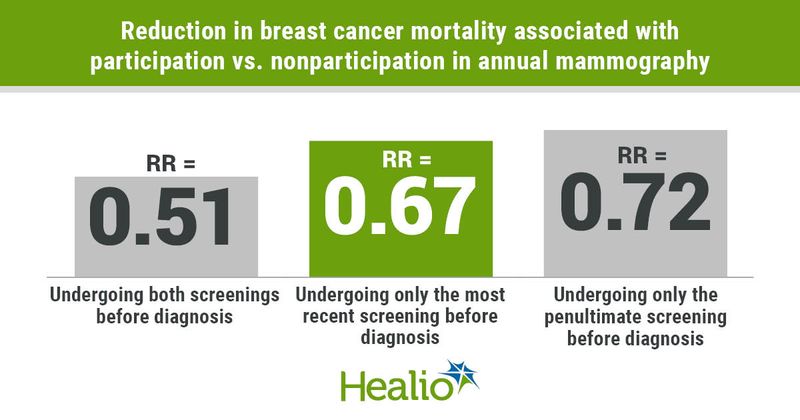Regularly attending screening mammography reduces breast cancer mortality risk
Undergoing mammography for 2 consecutive years before a breast cancer diagnosis conferred a significant reduction in mortality compared with skipping one or both screenings, according to prospective study results published in Radiology.
The reduction in risk lessened for women who missed even one of the previous two examinations, according to the researchers.

“Our previous work showed a benefit of screening participation when defined as participation in the most recent screen only. We therefore wanted to know the benefit of regular screening compared with irregular screening,” Stephen W. Duffy, BSc, MSc, CStat, researcher at the Centre for Cancer Prevention and professor of cancer screening at Queen Mary University of London, told Healio. “The screen that can save a life is the screen that detects a cancer early. There is clearly a greater likelihood of one’s life being saved if one attends regular scheduled screens.”

Duffy and colleagues gathered data on 549,091 women (average age, 58.9 years) included in national Swedish registries between 1992 and 2016 to estimate the effect of successive screening mammography examinations on breast cancer mortality.
Researchers calculated incidence-based mortality based upon whether women underwent both screenings (serial participants; n = 392,135), only the most recent screening before a diagnosis (intermittent participants; n = 41,746), only the penultimate screening before a diagnosis (lapsed participants; n = 30,945) or neither screening (serial nonparticipants; n = 84,265).
Researchers used Poisson regression analysis to assess incidence-based breast cancer mortality rates. They additionally assessed the incidence of fatal breast cancers within 10 years.
Results showed that compared with serial nonparticipants, serial participants had a 49% lower risk for breast cancer mortality (RR = 0.51; 95% CI, 0.48-0.55) and a 50% lower risk for death of breast cancer within 10 years of a diagnosis (RR = 0.5; 95% CI, 0.46-0.55).
Serial participation also was associated with a significant reduction in breast cancer mortality compared with intermittent participation (RR = 0.77; 95% CI, 0.69-0.86) and lapsed participation (RR = 0.7; 95% CI, 0.61-0.8).
Researchers observed lesser reductions in breast cancer mortality associated with intermittent (RR = 0.67; 95% CI, 0.59-0.76) and lapsed (RR = 0.72; 05% CI, 0.63-0.83) participation compared with serial nonparticipation.
Of note, researchers observed no significant difference in mortality between intermittent and lapsed participants (RR = 0.92; 95% CI, 0.78-1.08).
“Our study reinforces the principle that early detection continues to confer a reduction in the risk [for] dying [of] breast cancer, even in this age of effective adjuvant systemic treatments,” Duffy said. “We have also shown that this benefit can be maximized by serial attendance for screening. The implication of this is that the screening experience should be made safe, acceptable and positive as possible so that women undergoing screening will come back next time.”
These results reinforce the idea that “early detection saves lives,” according to Renee Kendzierski, DO, assistant professor of clinical radiology and section chief of breast imaging at Temple University Hospital, who was not involved in the study.
“If you are diligent about getting an annual mammogram, if anything develops in your breast, it is usually small and patients do well,” she told Healio. “Conversely, if patients skip years between mammograms, there is more of a chance of larger tumor size, advanced disease and distant metastasis. Breast cancer is treatable, but to catch it in its early stages significantly improves a patient’s prognosis”
Future research should examine these results further to determine what extent the additional benefit of serial attendance is driven by stage-shifting of screening detection or interval cancers, Duffy said.
“If someone attends regular screening, this may add a limitation on the extent to which a tumor may grow in the interval between screens,” he said. “It would also be useful to examine stage of disease and survival by time since last screening and by demographics, such as age. This might inform screening frequency for different populations in the future.”
For more information:
Stephen W. Duffy, BSc, MSc, CStat, can be reached at Queen Mary University of London, Mile End Road, London E1 4NS; email: s.w.duffy@qmul.ac.uk.
Renee Kendzierski, DO, can be reached at Temple University Hospital – Main Campus, 3401 N. Broad St., Philadelphia, PA 19140.

